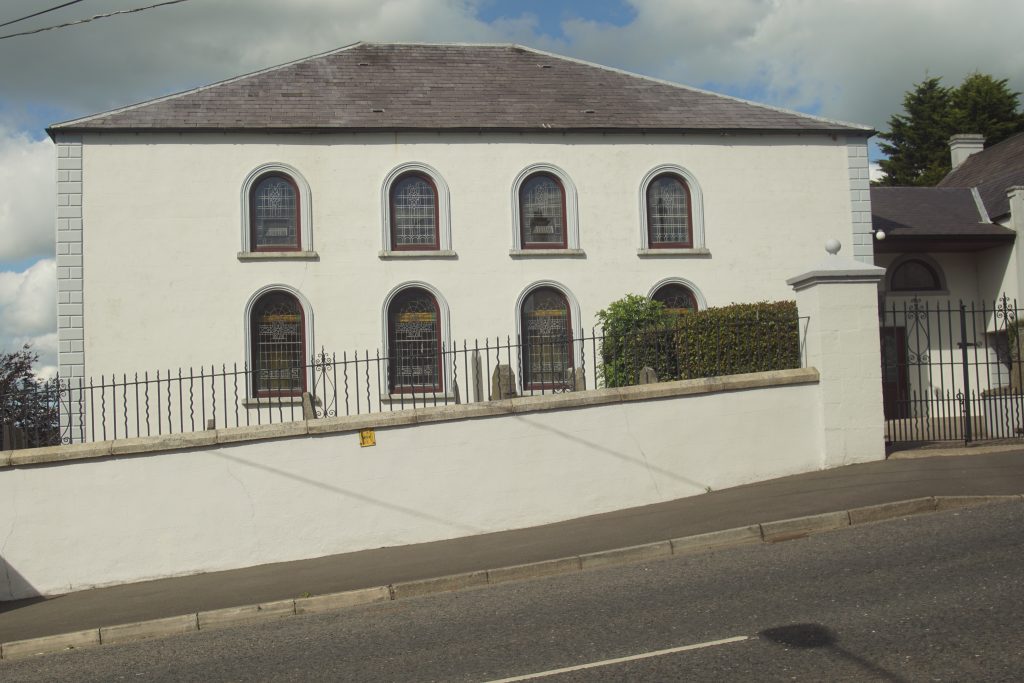First Rathfriland Presbyterian Church

This is one of the oldest foundations under the jurisdiction of the General Assembly. It dates back to 1662 from the time of the Restoration and has an unbroken record from then until the present time.
The Rev R G A Morrison in his book in 1962 refers to Rathfriland and the surrounding area in the mid-seventeenth century as densely wooded, uncultivated, where deer, wild boar and wolves roamed.
Industrious Scottish settlers built houses, cleared land, developed drainage and planted crops. In the late seventeenth century, new settlers from England arrived who mingled with the Scots and the Irish. The contrast between these groups was marked, and soon became evident in subsequent history both at local and national level.
The tablet over the church doors bears the following inscription- “Congregation erected A.D. 1662. Meeting House built A.D. 1679. Rev Alex Gordon, Minister. Succeeded by Rev Robert Gordon, A.D. 1711. Meeting House rebuilt A.D. 1775. Rev Samuel Barber, minister. Ceiled and improved A.D Rev John White, minister.” From historic sources we learn that ministers included in 1657 the Rev Robert Huetson who had a grant of £150 a year from Cromwell’s Government was minister of Rathfriland.
In 1661 the Rev James Campbell was minister of the parish, between 1662 and 1679 the Rev Alex Gordon became minister and continued in office until his death on 13 February 1708.
About this time there was further ecclesiastical hostility against the Presbyterians, and the Presbyterian Church of Rathfriland, like other churches elsewhere, had its doors nailed up, so that for a time no service could be held in it. Eventually, however, the opposition was overcome – the congregation was divided by the Presbytery, part of it thereafter worshipping, as their successors still worship at Ballyroney.
In 1711 the Rev Robert Gordon was ordained minister in Rathfriland. He continued as the pastor for 51 years, dying on 10 April 1762.
In 1705 the Rev Samuel Barber, A.M., one of the more interesting ministers was ordained, and died in this charge on 6 September 1811. He was an eminent man intellectually, and some of his published writings bearing dates 1772 and 1787, are in the library of Magee College, Londonderry. In the troubled years prior to the Rebellion of 1798, he was an officer of the Volunteers. (For more information on Volunteers and United Irishmen please visit our website.) Sometime later, Mr Barber fell under suspicion in consequence of remarking when he heard of a man near Newry having been hanged in his own garden without judge or jury, that “the country had best look to itself when such things could be done.” For this he was arrested, confined in Belfast in a military guardhouse, then sentenced and lodged in Downpatrick jail, from which however, he was soon after liberated. Local tradition says that the Church was surrounded by soldiers on a certain Sabbath, and that Mr Barber was arrested in the pulpit.
During Mr Barber‘s ministry the lease of the church was obtained. It is dated 21st day of May 1768. Mr Barber lies buried in the First Rathfriland Churchyard, where his tombstone, erected by the congregations, bears the following inscription – “An able servant of Christ, fearless advocate of the right of private judgement in matters of faith and steady friend of civil and religious liberty.”
In 1813, on 21 September, the Rev John White, A.M., was ordained, and died in the pastorate on the 2 April 1836. Up to Mr White’s ministry, there was no other Presbyterian Church belonging to the Synod of Ulster in Rathfriland or the surrounding district of the country, except Ballyroney. The Rathfriland congregation then as Mr White told the Presbytery at a meeting for ‘visitation’ consisted of from 1,300 to 1,480 families. It was said that not only were the pews full but one row of worshippers stood in each pew in front of the sitters who occasionally exchanged places with them to relieve their weariness. In addition, there were two rows of people who sat back-to-back, and the lower windows of the church were thrown up so that the people crowding about them outside might hear and join in the service. An elder in those days, Mr Halliday, a cabinet maker, built a pew for himself, and placed it in the aisle in front of the pulpit, and this, to make room, was wheeled out at communion times.
